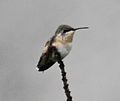Mellisugini
| Mellisugini | |
|---|---|

| |
| Bee hummingbird (Melisuga helenae) | |
| Scientific classification | |
| Domain: | Eukaryota |
| Kingdom: | Animalia |
| Phylum: | Chordata |
| Class: | Aves |
| Clade: | Strisores |
| Order: | Apodiformes |
| Family: | Trochilidae |
| Subfamily: | Trochilinae |
| Tribe: | Mellisugini Reichenbach, 1854 |
| Genera | |
|
16, see text | |
Mellisugini is one of the three
The informal name "bees" has been proposed for this group as it includes the tiny bee hummingbird (Mellisuga helenae) that is endemic to Cuba.[1]
The tribe contains 37 species divided into 16 genera.[2][3]
Phylogeny
A
| Trochilidae |
| ||||||||||||||||||||||||||||||||||||||||||||||||
The cladogram below shows the relationships between the genera and is based on a
| Mellisugini |
| |||||||||||||||||||||||||||||||||||||||||||||||||||||||||||||||||||||||||||||||||||||||||||||
The genus Calliphlox was found to be
The genus Atthis containing the wine-throated hummingbird and the bumblebee hummingbird was embedded within Selasphorus.[2][10] The genera were therefore merged and as under the rules of the International Code of Zoological Nomenclature Selasphorus has priory over Atthis the two species were moved to Selasphorus.[3]
Distinguishing features
The males of most species in the tribe Mellisugini have specialized tail feathers that produce sounds during their courtship display. This is not restricted to this tribe as males in the genus Discosura belonging to the tribe Lesbiini (coquettes) can also produce sounds from their tail feathers.[13][14]
Most of the migratory hummingbirds are found in this tribe. Remarkable examples are the rufous hummingbird (Selasphorus rufus) that breeds as far north as western Canada and Alaska and overwinters in Mexico and the ruby-throated hummingbird (Archilochus colubris) that breeds in the eastern United States and then crosses the Gulf of Mexico to winter in Mexico and Central America. There are five other long-distance migrants in the tribe: the broad-tailed hummingbird (Selasphorus platycercus), the calliope hummingbird (Selasphorus calliope), Allen's hummingbird (Selasphorus sasin), the black-chinned hummingbird (Archilochus alexandri) and the lucifer sheartail (Calothorax lucifer). It is likely that migratory behaviour has evolved several times.[10]
Taxonomic list
The tribe contains 17 genera.[3]
| Image | Genus | Living species |
|---|---|---|
 |
Calliphlox |
|
 |
Myrtis |
|
 |
Rhodopis |
|
 |
Myrmia |
|
 |
Thaumastura |
|

|
Philodice |
|
 |
Eulidia |
|
 |
Microstilbon |
|
 |
Chaetocercus |
|
 |
Tilmatura |
|
 |
Doricha |
|
 |
Calothorax |
|
 |
Archilochus |
|
 |
Mellisuga |
|
 |
Nesophlox |
|
 |
Calypte |
|
 |
Selasphorus |
|
References
- PMID 9066799.
- ^ PMID 24704078.
- ^ Rasmussen, Pamela, eds. (July 2020). "Hummingbirds". IOC World Bird List Version 10.2. International Ornithologists' Union. Retrieved 10 January 2020.
- ^ PMID 17934998.
- ^ Dickinson & Remsen 2013, p. 133.
- ^ .
- ^ Reichenbach, Ludwig (1854). "Aufzählung der Colibris Oder Trochilideen in ihrer wahren natürlichen Verwandtschaft, nebst Schlüssel ihrer Synonymik". Journal für Ornithologie (Supplement) (in German). 1: 1–24 [6].
- PMID 9066799.
- ^ Dickinson & Remsen 2013, pp. 105–136.
- ^ PMID 28583078.
- ^ Donsker, David B.; Rasmussen, Pamela C.; Mason, Nicholas A. (September 2020). "Proposal 886: Resurrect Philodice as a separate genus from Calliphlox". South American Classification Committee, American Ornithological Society. Retrieved 12 January 2020.
- ^ Donsker, David B.; Rasmussen, Pamela C.; Mason, Nicholas A. (8 September 2020). Proposal 2021-A-12: Resurrect Philodice as a separate genus from Calliphlox (PDF) (Report). North American Classification Committee, American Ornithological Society. pp. 63–66.
- S2CID 12248122.
- PMID 29380351.
Sources
- ISBN 978-0-9568611-0-8.
